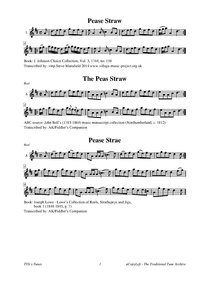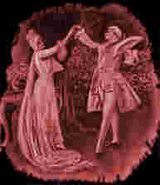Template:Pagina principale/Vetrina: Difference between revisions
No edit summary |
No edit summary |
||
| Line 1: | Line 1: | ||
{{SheetMusic | {{SheetMusic | ||
|f_track= | |f_track=Pease Strae.mp3 | ||
|f_pdf= | |f_pdf=Pease Strae.pdf | ||
|f_artwork= | |f_artwork=Cushion Dance.jpg | ||
|f_tune_name= | |f_tune_name=Pease Strae | ||
|f_track_title= | |f_track_title=Pease Strae | ||
|f_section= | |f_section=abc | ||
|f_played_by=[https://soundcloud.com/ | |f_played_by=[https://soundcloud.com/ella-pauly Ella Pauly] | ||
|f_notes= | |f_notes= Cushion Dance. | ||
|f_caption= | |f_caption=Northumbrian collector John Stokoe noted in the Bell Manuscript that the tune was used in Northumberland for the Cushion Dance, to a dance similar to "Joan Sanderson," popular in the 16th century. | ||
|f_source=[https://soundcloud.com/ | |f_source=[https://soundcloud.com/ella-pauly/clean-pease-strae Soundcloud] | ||
|f_pix=420 | |f_pix=420 | ||
|f_picpix=200 | |f_picpix=200 | ||
|f_article=[[ | |f_article=[[Pease Strae | '''Pease Strae''']] | ||
Instructions for a country dance to the melody can be found in the Scottish '''Holmain Manuscript''', c. 1710-50, where it is alternately titled "[[Bathget Boys]]." Modern musicologist David Johnson (1988) also prints directions to a country dance called Pease Strae with the melody. Flett and Flett (1964) record that the same Scottish dance went by different names according to which tune was played to accompany it in a particular locale; thus the dance also was called "[[Duke of Perth]]" and "[[Brown's Reel (2)]]" in East Fife, Perthshire and Angus, and "[[Keep the Country Bonny Lassie]]" in the upper parts of Ettrick. The title Pease Strae for the series of dance steps was used in the area around Lanarkshire, Ayrshire, Arran and Galloway, and was taught by all the local dancing masters. Northumbrian collector John Stokoe noted in the Bell Manuscript that the tune was used in Northumberland for the Cushion Dance, to a dance similar to "[[Joan Sanderson]]," popular in the 16th century. Supporting this is the tunes entry in Northumbrian musician William Lister's music manuscript as "The Cuzin Dance." This dance survived for a time in a children's ring game with a cushion, called "The Best Bed of All," which included the chant: | |||
<blockquote> | |||
''The best bed of all,''{{break}} | |||
''the best bed in our house''{{break}} | |||
''is clean pease straw.''{{break}} | |||
''Pease straw is dirty,''{{break}} | |||
''will dirty all my gown;''{{break}} | |||
''"Never mind my bonny lass—''{{break}} | |||
''just lay the cushion down."''{{break}} | |||
</blockquote> | |||
}} | }} | ||
Revision as of 08:03, 14 May 2023

Played by: Ella Pauly
Source: Soundcloud
Image: Cushion Dance.

Instructions for a country dance to the melody can be found in the Scottish Holmain Manuscript, c. 1710-50, where it is alternately titled "Bathget Boys." Modern musicologist David Johnson (1988) also prints directions to a country dance called Pease Strae with the melody. Flett and Flett (1964) record that the same Scottish dance went by different names according to which tune was played to accompany it in a particular locale; thus the dance also was called "Duke of Perth" and "Brown's Reel (2)" in East Fife, Perthshire and Angus, and "Keep the Country Bonny Lassie" in the upper parts of Ettrick. The title Pease Strae for the series of dance steps was used in the area around Lanarkshire, Ayrshire, Arran and Galloway, and was taught by all the local dancing masters. Northumbrian collector John Stokoe noted in the Bell Manuscript that the tune was used in Northumberland for the Cushion Dance, to a dance similar to "Joan Sanderson," popular in the 16th century. Supporting this is the tunes entry in Northumbrian musician William Lister's music manuscript as "The Cuzin Dance." This dance survived for a time in a children's ring game with a cushion, called "The Best Bed of All," which included the chant:
The best bed of all,
the best bed in our house
is clean pease straw.
Pease straw is dirty,
will dirty all my gown;
"Never mind my bonny lass—
just lay the cushion down."
...more at: Pease Strae - full Score(s) and Annotations
X:1 T:Pease Straw B:J. Johnson Choice Collection, Vol. 3, 1744, no. 158 Z:vmp.Steve Mansfield 2014 www.village-music-project.org.uk M:C L:1/8 K:D V:1 clef=treble name="1." [V:1] A | d>efd gefd | eA2B =c2BA | d>efd gefd | (f/g/a)A2 d3 :| |: (f/g/) |a/g/f/e/ d(f/g/) a/g/f/e/ df | eA2B =c2BA | d>efd gefd | f/g/aA2 d3 :|
